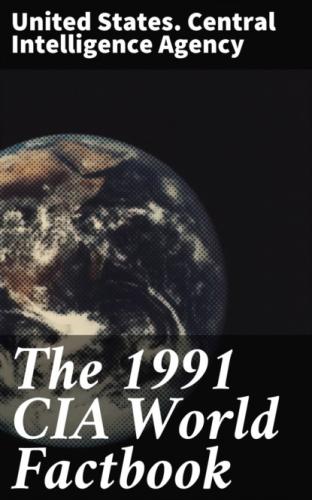United States. Central Intelligence Agency
The 1991 CIA World Factbook
Published by Good Press, 2019
EAN 4057664654632
Table of Contents
THE WORLD FACTBOOK
_@Afghanistan *Geography #_Total area: 647,500 km2; land area: 647,500 km2
_#_Comparative area: slightly smaller than Texas
_#_Land boundaries: 5,826 km total; China 76 km, Iran 936 km, Pakistan 2,430 km, USSR 2,384 km
_#_Coastline: none—landlocked
_#_Maritime claims: none—landlocked
_#_Disputes: Pashtun question with Pakistan; Baloch question with Iran and Pakistan; periodic disputes with Iran over Helmand water rights; insurgency with Iranian and Pakistani involvement; traditional tribal rivalries
_#_Climate: arid to semiarid; cold winters and hot summers
_#_Terrain: mostly rugged mountains; plains in north and southwest
_#_Natural resources: natural gas, crude oil, coal, copper, talc, barites, sulphur, lead, zinc, iron ore, salt, precious and semiprecious stones
_#_Land use: arable land 12%; permanent crops NEGL%; meadows and pastures 46%; forest and woodland 3%; other 39%; includes irrigated NEGL%
_#_Environment: damaging earthquakes occur in Hindu Kush mountains; soil degradation, desertification, overgrazing, deforestation, pollution
_#_Note: landlocked
_*People #_Population: US Bureau of the Census—16,450,304 (July 1991), growth rate 5.2% (1991) and excludes 3,750,796 refugees in Pakistan and 1,607,281 refugees in Iran; note—another report indicates a July 1990 population of 16,904,904, including 3,271,580 refugees in Pakistan and 1,277,700 refugees in Iran
_#_Birth rate: 44 births/1,000 population (1991)
_#_Death rate: 20 deaths/1,000 population (1991)
_#_Net migration rate: 28 migrants/1,000 population (1991); note—there are flows across the border in both directions, but data are fragmentary and unreliable
_#_Infant mortality rate: 164 deaths/1,000 live births (1991)
_#_Life expectancy at birth: 44 years male, 43 years female (1991)
_#_Total fertility rate: 6.3 children born/woman (1991)
_#_Nationality: noun—Afghan(s); adjective—Afghan
_#_Ethnic divisions: Pashtun 50%, Tajik 25%, Uzbek 9%, Hazara 12–15%; minor ethnic groups include Chahar Aimaks, Turkmen, Baloch, and other
_#_Religion: Sunni Muslim 84%, Shia Muslim 15%, other 1%
_#_Language: Pashtu 50%, Afghan Persian (Dari) 35%, Turkic languages (primarily Uzbek and Turkmen) 11%, 30 minor languages (primarily Balochi and Pashai) 4%; much bilingualism
_#_Literacy: 29% (male 44%, female 14%) age 15 and over can read and write (1990 est.)
_#_Labor force: 4,980,000; agriculture and animal husbandry 67.8%, industry 10.2%, construction 6.3%, commerce 5.0%, services and other 10.7%, (1980 est.)
_#_Organized labor: some small government-controlled unions
_*Government #_Long-form name: Republic of Afghanistan
_#_Type: authoritarian
_#_Capital: Kabul
_#_Administrative divisions: 30 provinces (velayat,
singular—velayat); Badakhshan, Badghis, Baghlan, Balkh,
Bamian, Farah, Faryab, Ghazni, Ghowr, Helmand,
Herat, Jowzjan, Kabol, Kandahar, Kapisa, Konar,
Kondoz, Laghman, Lowgar, Nangarhar, Nimruz, Oruzgan,
Paktia, Paktika, Parvan, Samangan, Sar-e Pol,
Takhar, Vardak, Zabol; note—there may be a new province of
Nurestan (Nuristan)
_#_Independence: 19 August 1919 (from UK)
_#_Constitution: adopted 30 November 1987, revised May 1990
_#_Legal system: has not accepted compulsory ICJ jurisdiction
_#_National holiday: Anniversary of the Saur Revolution, 27 April (1978)
_#_Executive branch: president, four vice presidents, prime minister, deputy prime minister, Council of Ministers (cabinet)
_#_Legislative branch: bicameral National Assembly (Meli Shura) consists of an upper house or Council of Elders (Sena) and a lower house or Council of Representatives (Wolosi Jirga)
_#_Judicial branch: Supreme Court
_#_Leaders:
Chief of State and Head of Government—President (Mohammad)
NAJIBULLAH (Ahmadzai) (since 30 November 1987); First Vice President
Abdul Wahed SORABI (since 7 January 1991); Prime Minister Fazil Haq
KHALIQYAR (since 21 May 1990)
_#_Political parties and leaders: main party—Hizbi Watan Homeland Party (formerly known as the People's Democratic Party of Afghanistan or PDPA); there are other, much smaller political parties recognized by the government
_#_Suffrage: universal, male ages 15–50
_#_Elections:
Senate—last held NA April 1988 (next to be held April 1991); results—Hizbi Watan was the only party; seats—(192 total, 128 elected) Hizbi Watan 128;
House of Representatives—last held NA April 1988 (next to be held April 1993); results—Hizbi Watan was the only party; seats—(234 total) Hizbi Watan 184, opposition 50; note—members may or may not be affiliated with a political party
_#_Communists: Hizbi Watan Homeland Party (formerly the People's Democratic Party of Afghanistan or PDPA) claims 200,000 members and no longer considers itself a Communist party
_#_Other political or pressure groups: the military and other branches of internal security have been rebuilt by the USSR; insurgency continues throughout the country; widespread antiregime sentiment and opposition on religious and political grounds
_#_Member of: AsDB, CP, ESCAP, FAO, G-77, IAEA, IBRD, ICAO, IDA, IDB, IFAD, IFC, ILO, IMF, INTELSAT, IOC, ITU, LORCS, NAM, OIC, UN, UNCTAD, UNESCO, UNIDO, UPU, WFTU, WHO, WMO, WTO; note—Afghanistan was suspended from the OIC in January 1980, but in March 1989 the self-proclaimed Mujaheddin Government of Afghanistan was given membership
_#_Diplomatic representation: Minister-Counselor, Charge d'Affaires Abdul Ghafur JOUSHAN; Chancery at 2341 Wyoming Avenue NW, Washington DC 20008; telephone (202) 234–3770 or 3771;
US—Charge
